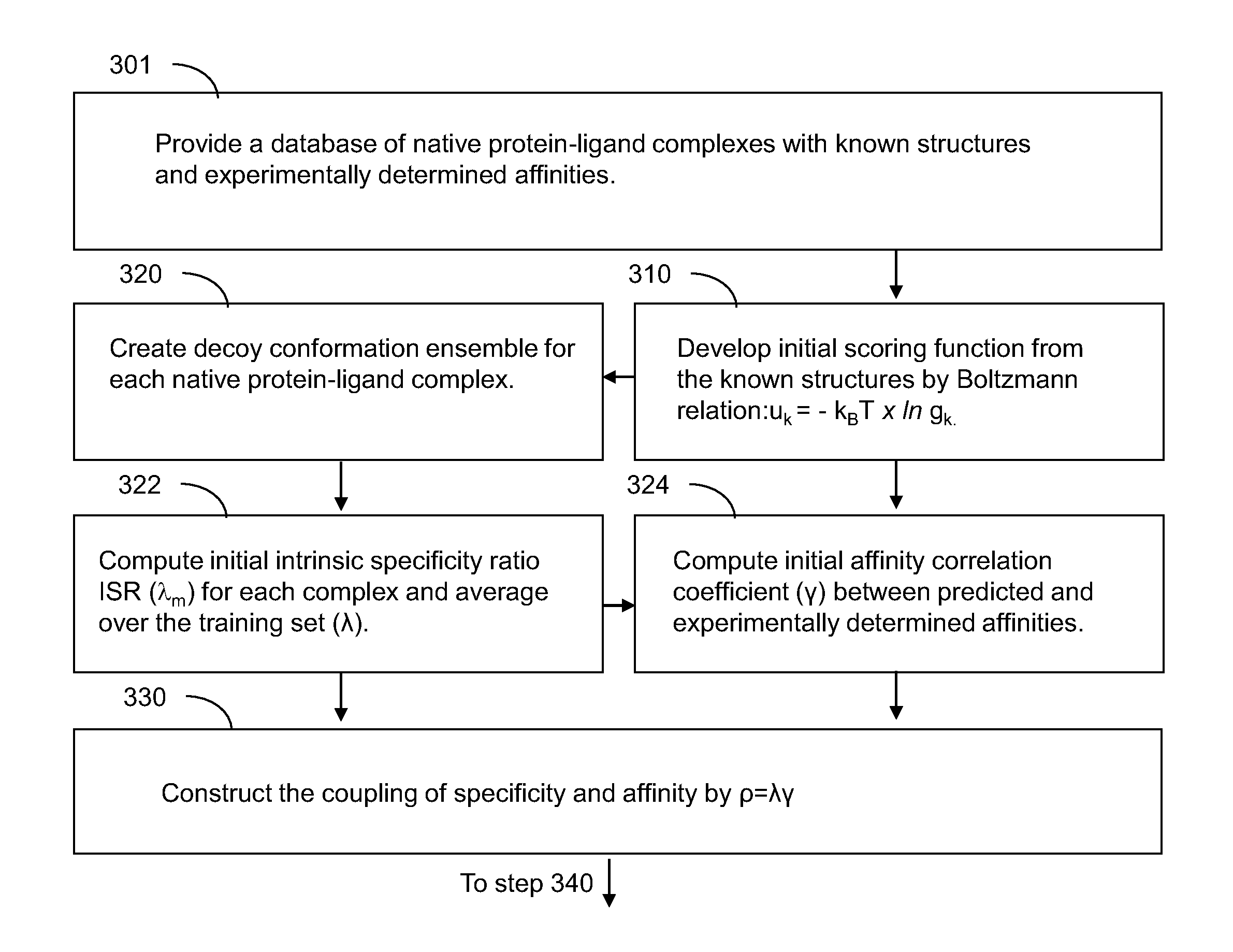Specificity quantification of biomolecular recognition and its application for drug discovery
Inactive Publication Date: 2013-06-27
YAN ZHIQIANG +1
View PDF0 Cites 6 Cited by
- Summary
- Abstract
- Description
- Claims
- Application Information
AI Technical Summary
Benefits of technology
[0011]According to an aspect of the present disclosure, a method of generating a scoring function for quantifying characteristics of protein-ligand bindings is provided. The method includes steps of: generating an initial form of a scoring function that represents a quantity derived from a total intermolecular energy of each protein-ligand complex by providing different weighting to each type of atom pair potentials; generating an average intrinsic specificity ratio that is a ratio of an energy gap between an energy of a native conformation and an average energy of the ensemble of decoys to a width of energy distribution of the ensemble of decoys; generating an affinity correlation coefficient between a set of experimentally measured values of affinity and a set of predicted values of affinity as generated from the scoring function; generating a combination parameter that strictly increases with any increase in the intrinsic specificity ratio and with any increase in the affinity correlation coefficient; iteratively modifying the scoring function, the intrinsic specificity ratio, and the affinity correlation coefficient by changing values of the different weighting of atom pair potentials; and finalizing a functional form of the scoring function by accepting final values of the different weighting when the iterative modification results in a convergence. At least one step of the generation of the scoring function, the generation of the average intrinsic specificity ratio, the generation of the affinity correlation coefficient, the generation of the combination parameter, and the iterative modification of the scoring function, the intrinsic specificity ratio, and the affinity correlation coefficient is performed employing a computing system including one or more processors in communication with a memory.
[0012]According to another aspect of the present disclosure, a method of characterizing affinity and specificity of each compound bound to a target protein is provided. The method comprises providing a finalized scoring function employing a method described above, and determining a score for each selected lead compound employing the finalized form of the scoring function. Compounds with high scores can be subsequently identified as lead compounds, for example, by selecting the lead compounds having scores greater than a predetermined threshold value or by selecting a preset number of lead compounds having highest scores.
[0013]According to even another aspect of the present disclosure, a system for generating a scoring function for quantifying characteristics of protein-ligand bindings is provided. The system includes one or more processors in communication with a memory and is configured to run a computer program. The computer program includes steps of: generating an initial form of a scoring function that represents a quantity derived from a total intermolecular energy of each protein-ligand complex by providing different weighting to each type of atom pair potentials; generating an average intrinsic specificity ratio that is a ratio of an energy gap between an energy of a native conformation and an average energy of the ensemble of decoys to a width of energy distribution of the ensemble of decoys; generating an affinity correlation coefficient between a set of experimentally measured values of affinity and a set of predicted values of affinity as generated from the scoring function; generating a combination parameter that strictly increases with any increase in the intrinsic specificity ratio and with any increase in the affinity correlation coefficient; iteratively modifying the scoring function, the intrinsic specificity ratio, and the affinity corr
Problems solved by technology
There are many docking algorithms available; however, imperfections of scoring functions continue to be a major limiting factor.
However, high affinity does not guarantee high specificity which is critical for function, e.g. drug-target recognition.
A gap in binding free energy or affinity will lead to significant population discrimination between the specific complex and non-specific ones.
In previous models for p
Method used
the structure of the environmentally friendly knitted fabric provided by the present invention; figure 2 Flow chart of the yarn wrapping machine for environmentally friendly knitted fabrics and storage devices; image 3 Is the parameter map of the yarn covering machine
View moreImage
Smart Image Click on the blue labels to locate them in the text.
Smart ImageViewing Examples
Examples
Experimental program
Comparison scheme
Effect test
 Login to View More
Login to View More PUM
 Login to View More
Login to View More Abstract
A novel scoring function called SPA takes account of both specificity and affinity of highly efficient and specific protein-ligand binding. The method to develop SPA is based on the funneled energy landscape theory and employs affinity and specificity of biomolecular interactions. The quantified specificity of the native protein-ligand complex, which discriminates against “non-native” binding modes, and the affinity prediction are simultaneously optimized during the development. SPA is obtained by maximizing the specificity and affinity prediction of a large training set of “native” protein-ligand complexes with known structures and affinities. SPA can be employed to discriminate drugs from the diversity set, or to discriminate selective drugs from non-selective drugs. The remarkable performance of SPA makes it promising to be implemented in the docking software and widely applied in virtual screening for seeking the lead compounds.
Description
CLAIM OF PRIORITY[0001]This application claims the benefit of priority from U.S. Provisional Application No. 61 / 579,891 filed with the United States Patent and Trademark Office on Dec. 23, 2011.STATEMENT REGARDING FEDERALLY SPONSORED RESEARCH OR DEVELOPMENT[0002]This invention was made with government support under grant number MCB0947767 awarded by the National Science Foundation. The government has certain rights in the invention.FIELD OF THE INVENTION[0003]The present invention relates to a method of modeling highly efficient and specific biomolecular recognition between protein and ligands and a system for implementing the sameBACKGROUND OF THE INVENTION[0004]Biomolecular recognition is central to cellular processes mediated by the formation of complexes between biomolecular receptors and their ligands. Understanding of biomolecular recognition is one of the most important issues in modern molecular biology and has direct applications in drug discovery and design. The fast and a...
Claims
the structure of the environmentally friendly knitted fabric provided by the present invention; figure 2 Flow chart of the yarn wrapping machine for environmentally friendly knitted fabrics and storage devices; image 3 Is the parameter map of the yarn covering machine
Login to View More Application Information
Patent Timeline
 Login to View More
Login to View More IPC IPC(8): G06F19/12G16B5/00G16B15/30
CPCG06F19/16G06F19/12G16B15/00G16B15/30G16B5/00
Inventor YAN, ZHIQIANGWANG, JIN
Owner YAN ZHIQIANG
Features
- R&D
- Intellectual Property
- Life Sciences
- Materials
- Tech Scout
Why Patsnap Eureka
- Unparalleled Data Quality
- Higher Quality Content
- 60% Fewer Hallucinations
Social media
Patsnap Eureka Blog
Learn More Browse by: Latest US Patents, China's latest patents, Technical Efficacy Thesaurus, Application Domain, Technology Topic, Popular Technical Reports.
© 2025 PatSnap. All rights reserved.Legal|Privacy policy|Modern Slavery Act Transparency Statement|Sitemap|About US| Contact US: help@patsnap.com



